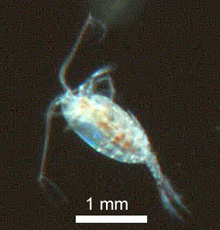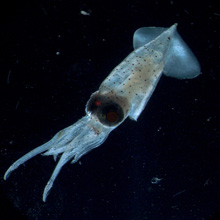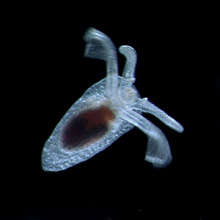Hunting for Zooplankton
October 13, 2007 — Log 2
Russ Hopcroft
Associate Professor
Institute of Marine Science
University of Alaska, Fairbanks
A major goal of this expedition has been to fill the void of imagery that exists for zooplankton compared to other ocean habitats. Three major approaches have been directed to this goal. Images through the ROV, macro-photography of animals collected by the remotely operated vehicle (ROV) and divers, and finally images collected through a microscope.
The vast majority of the ocean’s animal life, both in terms of mass and abundance, is zooplankton — they range in size from that of a human to a microscopic speck. In the early days of exploration, expeditions frequently enlisted artists to document the strange variety of life forms they encountered, but today this is done through digital photographs.
On this expedition I have been wearing two hats, the first as the primary scientist directing the movements of the ROV during its dives. The ROV excels at surveying large volumes of the ocean for the bigger and more fragile zooplankton that is either too rare or too fragile to be sampled with plankton nets. The best way to describe this that watching the camera’s field of view on the ROV control room’s monitor is like watching a Star Trek or Starfield screen saver, with a barrage of particles streaming toward you. The challenge is to identify animals as they zoom past and to identify the more interesting ones out in the distance in sufficient time to get the ROV to adjust its course, then stop without disturbing or "dusting" the animal.
Here in the Celebes Sea, where the abundance of larger deep-water zooplankton is low, a ROV dive generally consists of long periods of the mundane, interspersed with periods of huge excitement and discovery. The high currents experienced during most dives have presented a challenge, limiting how long the ROV can remain focused on an individual animal before its 'leash' to the clump weight and and the ship’s drift pulls it away. Generally, it’s difficult to record close-up video of an animal and also collect it, so generally we collect a specimen the first time an animal is observed, then record good video on the next encounter with the same species. Both rely on precision piloting, and the expedition has been fortunate to have Joe Caba on the flight controls during most dives.
Fig. 2. This Hydromeles globulosa, a gymnosome pteropod (a type of pelagic mollusc) just one micron long (one-thousandth of a millimeter) was photographed through Hopcroft’s microscope.
During my spare time, my second task has been microscopic imaging some of the more interesting and smaller specimens collected by the short hauls of plankton nets (figs. 1, 2). Even short hauls collect thousands of animals to sift through. The challenge to such work is finding undamaged charismatic animals, and photographing them on a vibrating and rolling ship — amidst all the expedition’s other time demands.
The diversity of size, shape and color within the samples can be amazing. Animals range from fully transparent, to brightly colored in reds, purples, yellows, greens, and blues. Some of their shapes seem better suited to science-fiction films than real science. The diversity of species in each of these samples will take days to fully assess, and I only wish I had more time to capture this diversity before these rich colors and transparency are extinguished by the preservatives into which they must be placed for long-term storage.





























